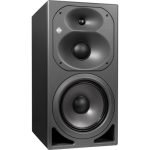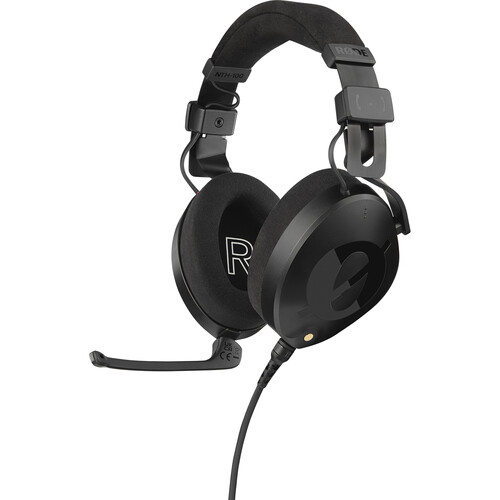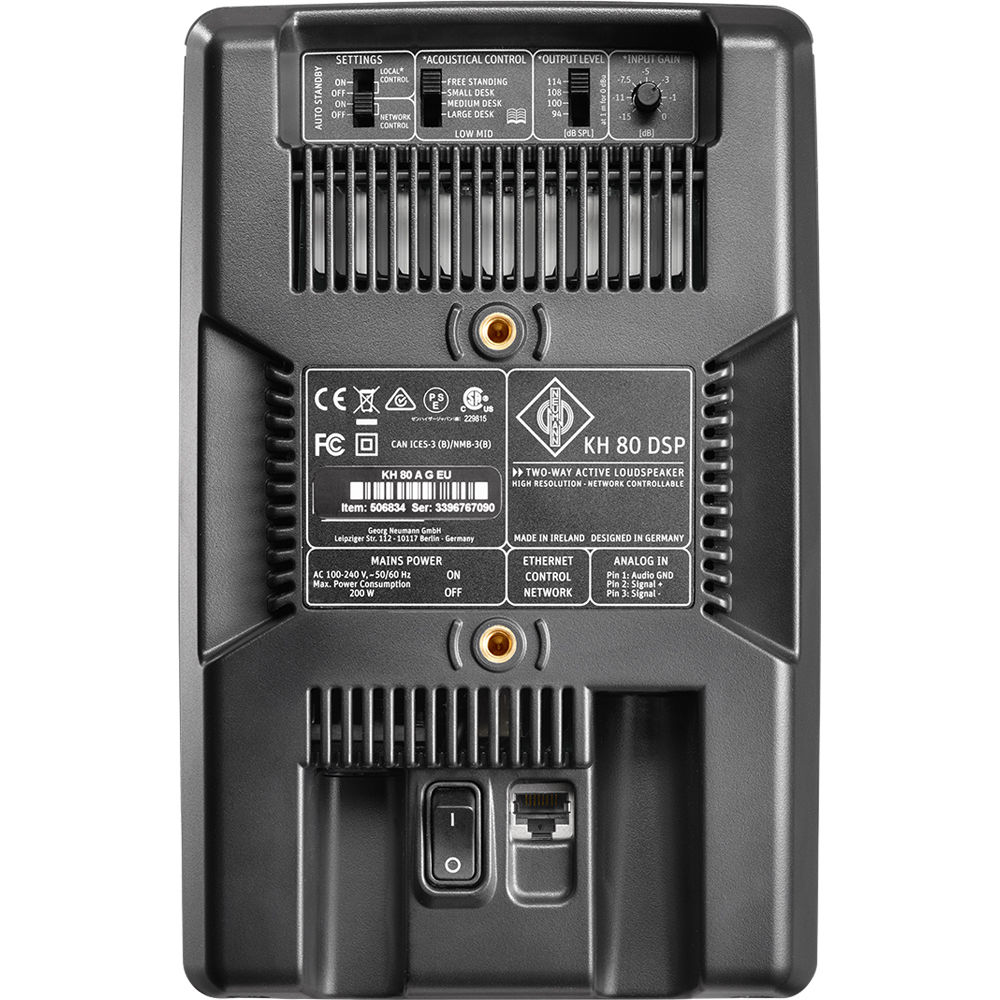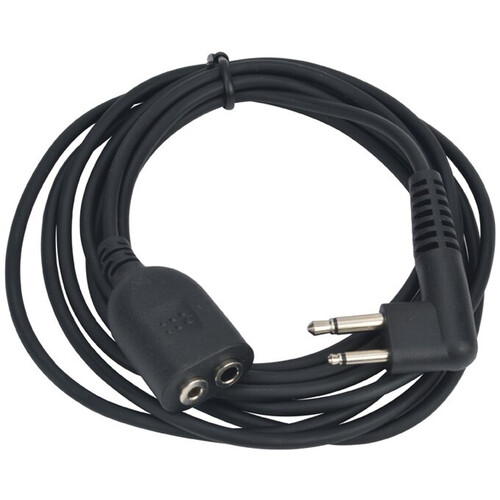Overview
The KH 420 is a high-quality, three-way tri-amplified monitor designed for a working distance of 1.5 to 3 meters. It features an in-house simulated tweeter with an alloy fabric dome and robust metal grille, as well as a rotatable elliptical Mathematically Modelled Dispersion™ (MMD™) waveguide for smoother off-axis response and wide horizontal dispersion. The monitor also includes a two-color + dimmable Neumann logo for displaying operation status and activation of the protection system.
In addition, the KH 420 boasts a variety of advanced features such as a parametric equalizer, wide range input gain and output level controls, and powerful amplifiers with large headroom and overheat limiting. Its computer mechanically modeled three-way cabinet design and Low resonance Integral Molding™ (LRIM™) materials help reduce cabinet resonances and standing wave resonances for a more transparent sound. With its precise dispersion and extensive mounting hardware range, the KH 420 is a reliable and flexible choice for professional audio monitoring.
Included in box
1 x KH 420 Studio Monitor
3 x Mains cables (European, UK and US version)
1 x Operating manual
1 x Supplement “Getting Started Quickly”
About the Neumann KH 420 G Studio Monitor
The KH 420 is designed for a working distance of 1.5 to 3 m (5’ to 9’). It handles this space effortlessly thanks to great power reserves and precisely concentrated dispersion. Even in diverse acoustical environments the KH 420 remains neutral and clear in every detail down to the subtlest nuances. No subtlety is lost; every sound element can be localized.
The KH 420 is a three-way tri-amplified monitor with thermally protected Class AB amplifiers (330 W and two times 140 W). Just like the drivers, its Mathematically Modeled Dispersion™ (MMD™) waveguide is engineered for optimum precision. Sound distributed in a horizontally precise manner ensures flexibility in the listening position; the narrower vertical dispersion reduces the negative effects of nearby reflections, for example from a desk or mixing console. The dispersion of the KH 420 is deliberately designed to be narrower, to guarantee reference sound at longer working distances.
The KH 420 is designed for midfield applications and as main monitor in project, music, broadcast and post-production studios for recording, mixing and mastering. And in a multi-channel system, it can also be freely combined with all other Neumann studio monitors.
With its tri-channel amplifiers the KH 420 also realizes sound pressures of up to 122.4 dB. And it thereby retains high-resolution and neutral representation across the entire frequency response. This also includes an exceptional bass response down to 26 Hz. Despite using ports, there is no “overhang” or audible resonance in the low frequency range and the transient response is precisely controlled at all times.
The computer modeled chassis is constructed of LRIM™ materials which eliminates standing wave resonances and suppresses intermodulation distortion, especially in the midrange.
For demanding treble, our own specially developed, powerful alloy fabric dome ensures distortion-free reproduction. The fabric dome captures the midrange with utmost precision. Its ultralight material and the powerful neodymium magnet enable a significantly better transient response with considerably less distortion than comparable midrange drivers.
The Digital Input Module DIM 1 expands the loudspeaker electronics by a digital XLR input, a digital BNC input and a digital BNC output (192 kHz/24 Bit) for flexible digital signal links. With the delay function (adjustment range 0 – 400 ms) of the DIM 1, the audio signal can be delayed to ensure audio-visual synchronization (lip sync). In addition, the high resolution of the delays (0.1 ms) allows equalization of the propagation delays. The delay can be added to both inputs (digital and analog). The KH 420 can be retrofitted with a DIM 1.
The KH 420 has also been developed true to the Neumann philosophy for monitor loudspeakers. Every component, every shape, every signal and every wave motion is a consequence of this philosophy. No form or component is there without reason. There are hundreds of tangible reasons built into the KH 420, which all stand for exceptionally pure and neutral sound. These include, for example, curvatures of the housing that reduce edge diffraction. Also included is the pistonic output of the bass driver which does not give rise to harmonic distortions, even with the highest sound peaks. Some of these reasons are obvious in the KH 420. Others Neumann prefers to keep to itself. But together, each can be heard – sound professionals in both large and small studios all around the world can testify to this.
Free field frequency response ±6 dB 25 Hz … 22 kHz
Free field frequency response ±3 dB 26 Hz … 22 kHz
Free field frequency linearity deviation between 100 Hz and 10 kHz ± 1.2 dB
Reproduction accuracy between 100 Hz and 10 kHz: 100%, 80%, 50% of loudspeakers produced ±0.78; ±0.36; ±0.22 dB
Self-generated noise at 10 cm (with input gain set to 100 dB SPL for 0 dBu) <20 dB(A) SPL
Sine wave output with a THD < 0.5 % at 1 m in half space 95 dB SPL (>100 Hz)
Max. SPL calc. in half space at 3% THD at 1m (averaged between 100 Hz and 6 kHz) 122.4 dB SPL
Max. SPL in full space at 3% THD at 1m (averaged between 100 Hz and 6 kHz) 116.4 dB SPL
Bass capability: Max. SPL in half space at 3% THD at 1m (averaged between 50 Hz and 100 Hz) 109.9 dB SPL
Max. short term SPL with IEC-weighted noise (IEC 60268-5) at 1 m, in typical listening conditions 109 dB(C) SPL
Max. short term SPL with music material at 2.3 m in typical listening conditions (pair / full range) 103 dB(C) SPL
Max. short term SPL with music material at 2.3 m, in typical listening conditions (pair with subwoofer) 109 dB(C) SPL
Max. long term SPL with pink noise at 2.3 m, in typical listening conditions (single / pair full range) 90 / 96 dB(C) SPL
Max. long term SPL with pink noise at 2.3 m, in typical listening conditions (single / pair with subwoofer) 90 / 96 dB(C) SPL
Analog input(s) XLR: analog electronically balanced
Analog input impedance >14k Ohms
Max. input level +24 dBu (DIM 1: 18 dBu for analog delayed)
Common mode rejection ratio (CMRR) >56 dB @ 15kHz
Input gain control (sensitivity) 0 dB … -15 dB
Output level control (output level in 1 m based on 0 dBu input level) 94; 100; 108; 114 dB SPL
Controller design Analog; active
Crossover frequency 570 Hz and 2.0 kHz
Crossover slope 24 dB/oct; 4th order
Equalization: Bass 0; -2.5; -5; -7.5 dB
Equalization: Mid 0; -1.5; -3; -4.5 dB
Equalization: Treble +1; 0; -1; -2 dB
Equalization: Parametric EQ: Gain ‘+4 … -12 dB
Equalization: Parametric EQ: Frequency Bypass, 25 … 80 Hz; 50 … 160 Hz; 100 … 320 Hz
Equalization: Parametric EQ: Q 1 … 8
Protection circuitry Independent thermo limiters for woofer, midrange dome and tweeter. Woofer soft clip and excursion limiters. Amplifier
overheat.
Infrasonic filter: frequency; slope 9 Hz; 18 dB/oct.
Display: On; Normal Operation Neumann logo “White”
Display: Limit / Clip / Errors / Protection /Boot Mute / Shut Down Mute Neumann logo “Red”
Display Brightness White: 100%/60%/30%/off; Red: 100%/60%/30%
Output power woofer amplifier (THD+N with limiter deactivated: 10%) 330 W
Output power midrange amplifier (THD+N with limiter deactivated: 10%) 140 W
Output power tweeter amplifier (THD+N with limiter deactivated: 10%) 140 W
Output power woofer amplifier (THD+N with limiter deactivated: 0.1%) 295 W
Output power midrange amplifier (THD+N with limiter deactivated: 0.1%) 130 W
Output power tweeter amplifier (THD+N with limiter deactivated: 0.1%) 130 W
Mains Power Supply: input voltage; frequency 100-240V; 50/60 Hz
Power consumption (230 V / 100 V): Idle 60 W (+5W when DIM 1 fitted)
Power consumption (230 V / 100 V): Full output 800 W
Cabinet material Wood cabinet, polyurethane waveguide, aluminum electronics panel
Cabinet surface finish; color (front / back) Painted; metallic anthracite (RAL 7021) / black (RAL 9005)
Operating conditions +10° C to +40° C (+50° F to +104° F); <90% RH, non-condensing
Transport/storage conditions -25° C to +70° C (-13° F to 158° F); <90% RH; non-condensing
Woofer 265 mm (10") with magnetic shielding
Midrange 75 mm (3") with magnetic shielding
Tweeter 25 mm (1") with protecting black metal grille
Mounting points 8 x M5 on rear panel
Product dimensions (height x width x depth) 645 x 330 x 444 mm (25 3/8" x 13" x 17 1/2")
External net volume 93 liters
Product weight 35.0 kg (77 lbs 3 oz) (+ 100 g (3 oz) with DIM 1 fitted)
Cabinet weight when electronics remote located 30.3 kg (66 lbs 13 oz) (+ 100 g (3 oz) with DIM 1 fitted)
Packed dimensions (height x width x depth), mm (inches) 775 x 610 x 590 mm (30 1/2" x 15" x 14 1/8")
Packed weight 41.0 kg (90 lbs 6 oz)
Packed cube 0.279 m³
*Please refer to the 2nd image above for more information*
(1)
In-house simulated tweeter with alloy fabric dome and robust metal grille
Latest modeling techniques used to minimize non-linear (harmonic and intermodulation) distortion
Low-distortion high frequency reproduction
Grille protects against mechanical damage
(2)
Rotatable elliptical Mathematically Modelled Dispersion™ (MMD™) waveguide
Smoother off -axis response
More forgiving of diverse acoustical environments
Wide horizontal dispersion
Freedom of movement across the mixing console
Narrow vertical dispersion
Reduces reflections off the mixing console
(3)
Two-color + dimmable Neumann logo
Displays operation status and activation of the extensive protection system
Dimmable for low lighting level conditions or behind the screen applications
(4)
In-house simulated, neodymium magnet, fabric dome, midrange driver with optimized low stray magnetic field
Dedicated driver reproduces important midrange frequencies, which is especially important for speech and vocals
Latest modeling techniques used to minimize non-linear (harmonic and intermodulation) distortion
Low-distortion midrange reproduction
Light-weight dome has better transient response and less breakup modes than cone designs
High power magnet reduces harmonic and intermodulation distortion
(5)
In-house modelled long-throw composite sandwich cone bass driver with Extremely Linear Force Factor™ (ELFF™), magnetic shielding and flow optimized die cast basket
Damping of break up modes brings low distortion at high sound levels
Linear pistonic motor gives a very low harmonic distortion even at high excursions
Reduced air noise and improved rocking modes
(6)
Large high-capacity flow-optimized bass reflex ports with pipe resonance damping
Fast bass transient response
Reduced bass compression at high output levels
No coloration from organ pipe resonance
Can be flush mounted
(7)
Computer mechanically modeled three-way cabinet design using Low resonance Integral Molding™ (LRIM™) materials
No standing wave resonances inside cabinet
Reduced intermodulation distortion in midrange for a more transparent sound
Reduced cabinet resonances
(8)
4-position bass, low-mid and treble acoustical controls
More control in diverse acoustical environments
Repeatable acoustical settings after moving loudspeakers
(9)
Parametric equalizer
More control in diverse acoustical environments
Bypassable if not needed
Three frequency ranges gives very fine control of equalization
(10)
Wide range input gain and output level controls
Easier interfacing with signal sources
(11)
Display dimmer
For low lighting level conditions or behind the screen applications
(12)
XLR electronically balanced analogue input with ground lift
Standard interfacing to professional equipment
Reduced noise in electrically noisy environments and over-comes ground loops
(13)
Universal dual (bass and mid/treble) switched-mode power supplies (100 … 240 V)
One version works in any country and robust to poor quality mains supply
Dual supply improves transient response
(14)
Fully documented extensive mounting hardware range
More flexibility in mounting cabinets in more diverse locations and backwards compatible to previous products
Easy advanced planning for installations
(15)
Electronics panel with generously dimensioned integrated Accelerated Heat Tunneling™ (AHT™) heat sink
Improved heat dissipation leading to increased electronics reliability
Installation flexibility
Remoteable electronics (REK 4) for ease of installation, less cabling, and convenience of use
(16)
Powerful amplifiers with large headroom and overheat limiting
Improved transient response
Assured reliability and safety
Separate fast acting thermo limiters for woofer, midrange and tweeter to protect the voice coils and power amplifiers
Woofer soft clip and excursion limiters
Increases system reliability
Allows extraction of the maximum performance from the system











Reviews
There are no reviews yet.